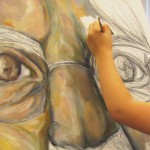First and foremost, you should buy a piece of art because you LOVE it and it speaks to you in some personal way. But often art can also be a financial investment. When contemplating the purchase of a piece of art, consider the following:
Q: Buying art can be intimidating. What’s the first step?
A: Start out at art fairs. Art fairs allows you to get an idea of which artists you like.
Q: Is it worthwhile to meet the artist?
A: Yes; it can be very rewarding and offers a new perspective.
Q: What’s a mistake that buyers make?
A: Many people buy a work with many editions by a big name artist and think it’s worth more than it is. Even if an artist is famous and he/she produces a large edition of a certain work, it may not appreciate as much as a smaller edition will.
Q: What does “limited edition” mean?
A: It means there were a limited number of prints made from an original work. An edition can be limited to any amount. At the bottom or the back of the work, you’ll see numbers that tell you where that particular print fell in the printing sequence and how many prints were made. So “25/50” means there were a total of 50 prints made and that yours was number 25. But it’s important to realize that number 5 and number 50 are equally valuable. Additionally, the artist usually keeps a few extra, which are called artist’s proofs, also known as APs.
Q: How can you tell if a piece of art will be a good investment?
A: See sales records for the artist you’re interested in. If an artist’s price continues to go up, then it’s a good indication that his/her work will at least hold its value. Or ask the gallery if you can take a look at the artist’s résumé. Has he/she been featured in any museums, collections, shows, or articles?
Q: Is there a certain type of art that’s a good deal to buy now?
A: Building a collection of contemporary photography is a great place for beginners to start. Photography is widely available and fits a variety of tastes and price ranges. Often the photos are printed in small editions, and they tend to be less expensive than oil paintings, which are single, unique pieces of artwork.












